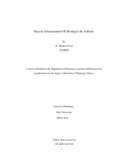| dc.contributor.advisor | Sharmin, Sabrina | |
| dc.contributor.author | Evan, Al- Shahriar | |
| dc.date.accessioned | 2022-11-21T04:16:12Z | |
| dc.date.available | 2022-11-21T04:16:12Z | |
| dc.date.copyright | 2022 | |
| dc.date.issued | 2022-03 | |
| dc.identifier.other | ID 18146045 | |
| dc.identifier.uri | http://hdl.handle.net/10361/17590 | |
| dc.description | This thesis is submitted in partial fulfillment of the requirements for the degree of Bachelor of Pharmacy, 2022. | en_US |
| dc.description | Cataloged from PDF version of thesis report. | |
| dc.description | Includes bibliographical references (pages 67-70). | |
| dc.description.abstract | It is quite visible that in the comparison to the patients having well-controlled asthma, patients having severe uncontrolled asthma do have disproportionately high rate of morbidity and also health-care usage. Whereas the treatment choices for these individuals were largely limited and associated with significant side/adverse effects, development of the biologic medicines in order to treat asthma has presented promising/efficient targeted/focused therapy that has shown potential in the clinical setting for the patients. Patients having endotype-driven by type-2 (T2) inflammation may benefit from biologic medicines as these target distinctive inflammatory pathways implicated in the pathogenesis/etiology of asthma. Beyond anti-IGE therapy, which has been shown to improve results within allergic-asthma for over a time periode that is somewhat a decade, 3 anti-ILn-5 biologic medicines as well as 1 anti-ILn-4R biologic drug appeared currently as quite prospective therapies for Type 2 asthma. Such specific/targeted treatment/therapies have indeed been demonstrated to minimize exacerbations of asthma, enhance lung capacity/function, lower the usage of OrCS, and enhance QuOL in individuals who have been correctly chosen. In addition to those biologic medicines that have already been authorized, other biologics that target/go for upstream mediators that are related to inflammation are presently being tested in the clinical trials, and there is high chance of the approval on the way in the near future. This article will be reviewing the MeOA, possible indications, projected benefits, also adverse effects of each of the already licensed biologics as well as highlight prospective therapeutic targets that will be covered up in future. Also in the articles, alarmins and anti-alarmins therapy are discussed . It is discussed in this article what the impacts of alarmins are and what the prospective function of anti-alarmins may be in the context/perspective of already available biologics. | en_US |
| dc.description.statementofresponsibility | AL-Shahrirar Evan | |
| dc.format.extent | 81 pages | |
| dc.language.iso | en | en_US |
| dc.publisher | Brac University | en_US |
| dc.rights | Brac University theses are protected by copyright. They may be viewed from this source for any purpose, but reproduction or distribution in any format is prohibited without written permission. | |
| dc.subject | Asthma | en_US |
| dc.subject | Biologics | en_US |
| dc.subject | Monoclonal-antibodies | en_US |
| dc.subject | Lung capacity/function | en_US |
| dc.subject | Interleukins | en_US |
| dc.subject.lcsh | Respiratory allergy | |
| dc.subject.lcsh | Antiasthmatic agents | |
| dc.title | Recent advancement of biologics in Asthma | en_US |
| dc.type | Thesis | en_US |
| dc.contributor.department | Department of Pharmacy, Brac University | |
| dc.description.degree | B. Pharmacy | |

